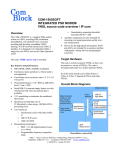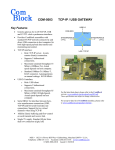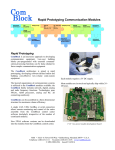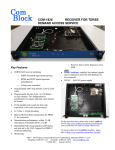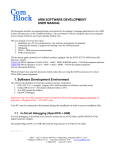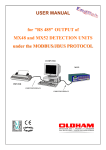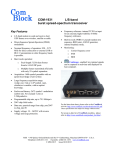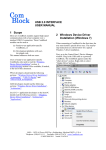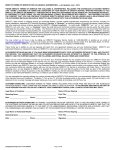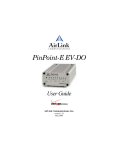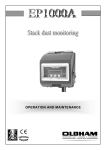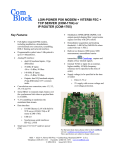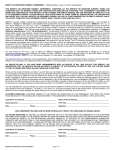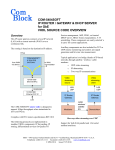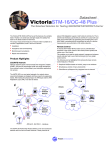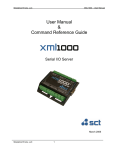Download ComScope User & Programming Manual
Transcript
COMSCOPE USER & PROGRAMMING MANUAL Overview New FPGA-based digital ComBlock modules are equipped with the ComScope data capture capability to help users visualize otherwise hidden digital signals. These modules are identified with Signal 1_3 Sample clock 1_3 source selection The data of interest is captured at speeds up to the FPGA processing speed. The user can select lower sampling rates to expand capture over a longer time period. Internal triggers or user (manual) trigger can be selected. Once the memory is full, data capture stops until re-armed by the user. Up to four data sources (Trace 1, Trace 2, Trace 3 and Trace 4) can be captured simultaneously. Depending on the source type, the data storage is organized as 4096 binary bits, 512 8-bit samples or 256 16-bit samples. Refer to specific ComBlock module specifications for the definition of signals, triggers and formats. To Trace1 display Signal 1_n Sample clock 1_n icon. re-arm trigger one-shot trigger Signal 2_1 Sample clock 2_1 Signal 2_2 Sample clock 2_2 Signal 2_3 Sample clock 2_3 Trace 2 4 Kbit Memory Trace 2 Multiplexer Internal digital signals, whether binary or digital representation of analog signals, can be stored in real-time within the internal memory, then exported to a host computer for plotting, storage and further processing. 256 samples x 16-bit or 512 samples x 8-bit or 4096 bits Signal 2_m Sample clock 2_m source selection 256 samples x 16-bit or 512 samples x 8-bit or 4096 bits re-arm trigger one-shot trigger Signal T_1 Sample clock T_1 Signal T_2 Sample clock T_2 Signal T_3 Sample clock T_3 To Trace2 display Trigger Multiplexer the Signal 1_2 Sample clock 1_2 Trace 1 4 Kbit Memory Trace 1 Multiplexer Signal 1_1 Sample clock 1_1 Signal T_x Sample clock T_x 03001802.dsf user-trigger source selection ComScope Functional Block Diagram (2 traces) Most ComScope settings are stored in volatile memory. They are loaded automatically by the ComBlock at power-up or reset. Several ComScope windows, each pertaining to a distinct ComBlock, can be opened at the same time. However, it should be noted that, in most cases, triggers cannot be synchronized across multiple ComBlocks. MSS • 18221 Flower Hill Way #A • Gaithersburg, Maryland 20879 • U.S.A. Telephone: (240) 631-1111 Facsimile: (240) 631-1676 www.ComBlock.com © MSS 2000-2005 Issued 8/11/2005 Starting ComScope Graphical User Interface User Manual Start the ComBlock Control Center, enumerate the ComBlocks, highlight the desired ComBlock and click on the icon as shown below: First Step The very first step in using ComScope is to consult the ComBlock specifications for definitions regarding the trace signals and trigger signals. For example, the COM-1028 FSK/MSK/GFSK/GMSK modulator specifications include the following trace and trigger signals definitions: Trace 1 signals Format 1: Data symbols before Gaussian filter 2: Data symbols after Gaussian filter 3: Frequency modulator phase 4: Modulated Signal I-channel Trace 2 signals 1: Internal PRBS11 test sequence 2: Modulated Signal Q-channel Trigger Signal 1: Start of internal PRBS11 test sequence 8-bit signed Nominal sampling rate 8 samples /symbol Buffer length (samples) 512 8-bit signed 8 samples /symbol 512 8-bit signed 8 samples /symbol 512 8-bit signed Format fclk (80 MHz) Nominal sampling rate 1 sample / bit fclk (80 MHz) 512 Binary 8-bit signed Format Binary Starting ComScope ComScope window The ComScope window is organized into three distinct control sections: (a) Trace settings on top (b) Plot settings on the lower left (c) Trigger settings on the lower right. Capture length (samples) 4096 512 Example of Trace/Trigger signals definition (COM-1028) In this example, trace 1 can capture and display one of four possible signals, all in 8-bit signed format. 512 samples of each signal are captured each time. Likewise, trace 2 can capture one of two signals: either 4096 samples of 1-bit binary data or 512 samples of 8-bit signed samples. Only one trigger signal is offered. ComScope window 3 control areas ComScope Trace Settings The Trace Settings section provides user control over the following trace attributes: Trace: select trace 1,2,3 or 4 to be configured. Signal: each trace can capture one of several multiplexed signals. Select the multiplexer source. Representation: enter the precision for the selected signal. Ranges from 1-bit binary to 16-bits. Also indicates whether the binary representation is unsigned or signed (2’s complement). Sampling clock: select between ‘nominal’ sampling clock as described in the specifications and the FPGA processing clock fclk. For example, in a digital modulator, waveform signals are typically 2 sampled at 4 samples per symbol (their ‘nominal’ sampling rate), whereas binary data streams may be typically sampled at 1 sample per bit (their ‘nominal’ sampling rate). When comparing different traces, it is often clearer to select a common clock (i.e. the FPGA processing clock fclk) as it ensures the same time scale. Decimation: select the sampling clock decimation. The main purpose of decimation is to ‘stretch’ the time scale, for example when a signal bandwidth is much smaller than the sampling clock frequency. Decimation can be selected by steps of 2 from 1:1 (no decimation) to 1:231 = 1: 2,147,483,648. One should be aware that capture duration increases as decimation factors increase. All above controls are stored in non-volatile memory within the ComBlock module. They are recalled at power up. User changes are enacted by pressing the “Apply Changes” button in the lower part of the ComScope window. The changes are applied the next time data is captured (i.e. after pressing the “Re-arm Trigger” button). Visible: this checkbox allows one to display one trace at a time, or all together. The captured data remains in memory while the trace is not visible. The selection is volatile (i.e. returns to the default value at power on). ComScope Trigger Settings The Trigger Settings section provides user control over the following trigger-related attributes: Signal: the trigger signal can be selected among several signals through a multiplexer. Alternatively, the trigger function can be disabled. Representation: enter the precision for the selected trigger signal. Ranges from 1-bit binary to 16-bits. Also indicates whether the binary representation is unsigned or signed (2’s complement). Threshold: enter the trigger threshold / level. Edge: enter the trigger edge / slope (rising or falling). Position: the trigger position determines how much data is captured before a valid trigger condition occurs. A vertical line at 0%, 10%, 50% or 90% of the displayed time identifies the trigger time. Plot style: select between small dots, big dots, lines and big dots and lines. The selection is volatile (i.e. returns to the default value at power on). Color: select the trace color from the palette. The selection is volatile (i.e. returns to the default value at power on). Export: export the trace samples to a decimal format text file for further processing using other applications, for example MS Excel (open or Data|Get external data| import text file) or Matlab (‘load’ command). All above controls are stored in non-volatile memory within the ComBlock module. They are recalled at power up. User changes are enacted by pressing the “Apply Changes” button in the lower part of the ComScope window. The changes are applied the next time data is captured (i.e. after pressing the “Re-arm Trigger” button). 3 ComScope Plot Settings Programming Interface This section is intended for designers who want to design their own graphical user interface. It can be skipped by ComBlock Control Center users. The display scale is automatically set when the ‘Auto scale’ checkbox is on. Otherwise, users can specify the display scale by entering the Xmin, Xmax, Ymin and Ymax values, then by clicking on the Rescale button. All ComScope-related commands are registermapped within the ComBlock. Registers 237 through 251 are reserved to this effect. All registers are 8-bit wide. Register mapping is as follows: Command The time axis (X-axis) is relative to the trigger: negative values represent samples captured before the trigger condition occurred and vice-versa. The time axis is expressed in ‘number of samples since the trigger’ units. All above controls are stored in non-volatile memory within the ComBlock module. They are recalled at power up. Trace n signal selection Trace n sampling clock selection ComScope Operations The key difference between a conventional oscilloscope and ComScope is that ComScope capture and display is always started manually. There is no automatic refresh. Re-arm Trigger: orders the ComBlock to capture a new batch of samples. If the capture is complete within approximately one second, the captured data is automatically displayed. If capture is incomplete or if the trigger condition did not yet occur, the user is invited to press either the ‘Force Trigger’ button (if trigger did not occur) and/or the ‘Plot button’ (if the capture is too slow). Trace n sampling clock decimation Definition 0 = disable trace n. 1-127 = signal selection. ComBlockspecific definition. See specifications. Non-volatile storage. n = 1: REG240 bits 6-0 n = 2: REG242 bits 6-0 n = 3: REG244 bits 6-0 n = 4: REG246 bits 6-0 0 = use nominal sampling clock as described in the specific ComBlock specifications. 1 = use the ComBlock fclk processing clock (typically 40MHz or 80 MHz or 120 MHz) as sampling clock. This allows to compare multiple signals on the same time scale. In either case, the sampling clock can be further decimated to stretch the time scale. (see decimation control below) n = 1: REG240 bit 7 n = 2: REG242 bit 7 n = 3: REG244 bit 7 n = 4: REG246 bit 7 Decimate selected signal sampling clock by 2n, where n = 0 through 31. 0 means no decimation. Non-volatile storage. n = 1: REG241 bits 4-0 n = 2: REG243 bits 4-0 n = 3: REG245 bits 4-0 n = 4: REG247 bits 4-0 Force Trigger: manual substitute to the automatic trigger condition. Must be used when the trigger is disabled. Plot: ask the ComBlock to provide the captured data. Keep pressing this button until the capture is complete. 4 Trigger position with respect to trace n capture window Trigger signal selection Signed/Unsigned trigger threshold Trigger edge Trigger threshold Force trigger Trigger re-arm Capture resume 0 = trigger set at 0% 1 = trigger set at 10% 2 = trigger set at 50% 3 = trigger set at 90% Note: All trigger positions must be identical. Use same value for all traces. Non-volatile storage. n = 1: REG241 bits 7-5 n = 2: REG243 bits 7-5 n = 3: REG245 bits 7-5 n = 4: REG247 bits 7-5 0 = trigger is off 1-63 = internal signal selection. ComBlock-specific definition. See specifications. Non-volatile storage. REG248 bits 5-0 0 = trigger threshold is unsigned 1 = trigger threshold is signed Non-volatile storage. REG248 bits 6 0 = falling edge 1 = rising edge Non-volatile storage. REG248 bit 7 When the selected trigger signal is an m-bit word, then the trigger threshold is given by: m =1: REG249 bit 0 m =2: REG249 bits 1-0 m =4: REG249 bits 3-0 m =8: REG249 m =10: 4 x REG249 m =16: 256 x REG249 One-shot trigger originated by the user. Write a ‘1’ once to force the manual trigger. Overrules the trigger signal selection. The trigger must have been re-armed before a force trigger may take place. Volatile. REG250 bit 0 One-shot command originated by the user. Writing a ‘1’ once will force the traces in use to switch state from “Capture in progress, pre-trigger” to “Capture in progress, waiting for trigger”. Volatile. REG250 bit 1 One-shot command originated by the user. Writing a ‘1’ once starts the capturing again after a capture was completed. REG250 bit 2 Monitoring Read data Capture in Progress Trigger Found Start Capture Toggle Trigger Rearm Toggle Definition ComScope trace data can be exported out of the ComBlock by reading at address 250. Stored data is read in sequence, starting at the initial address defined in REG237/238/239, and subsequently autoincremented after byte read at address 250. REG250 0 = capture ceased 1 = at least one trace is capturing REG251 bit 0 0 = trigger not found 1 = trigger found This bit is cleared (set to 0) upon resuming capture (see Read/Write register 250, bit 2). REG251 bit 1 This bit toggles every time capture is resumed (see Read/Write register 250, bit 2). REG251 bit 2 This bit toggles every the trigger is rearmed (see Read/Write register 250, bit 1). REG251 bit 3 The general M&C commands “Set Register SRG” and “Set Register Temporary SRT” are used to send commands to the ComBlock registers. See reference document “ComBlock Monitoring & Control Reference” www.comblock.com/download/M&C_reference.pd f FPGA/VHDL Development Platforms The ComBlock family of rapid prototyping modules includes several FPGA/VHDL development platforms (COM-1000, COM-1100, COM-1200, COM-1300, COM-1400, COM-8000) based on Xilinx FPGAs. VHDL code templates for these development platforms are being updated with basic ComScope source code. Template source code can be downloaded from www.comblock.com/download/com1000_002.zip 5





